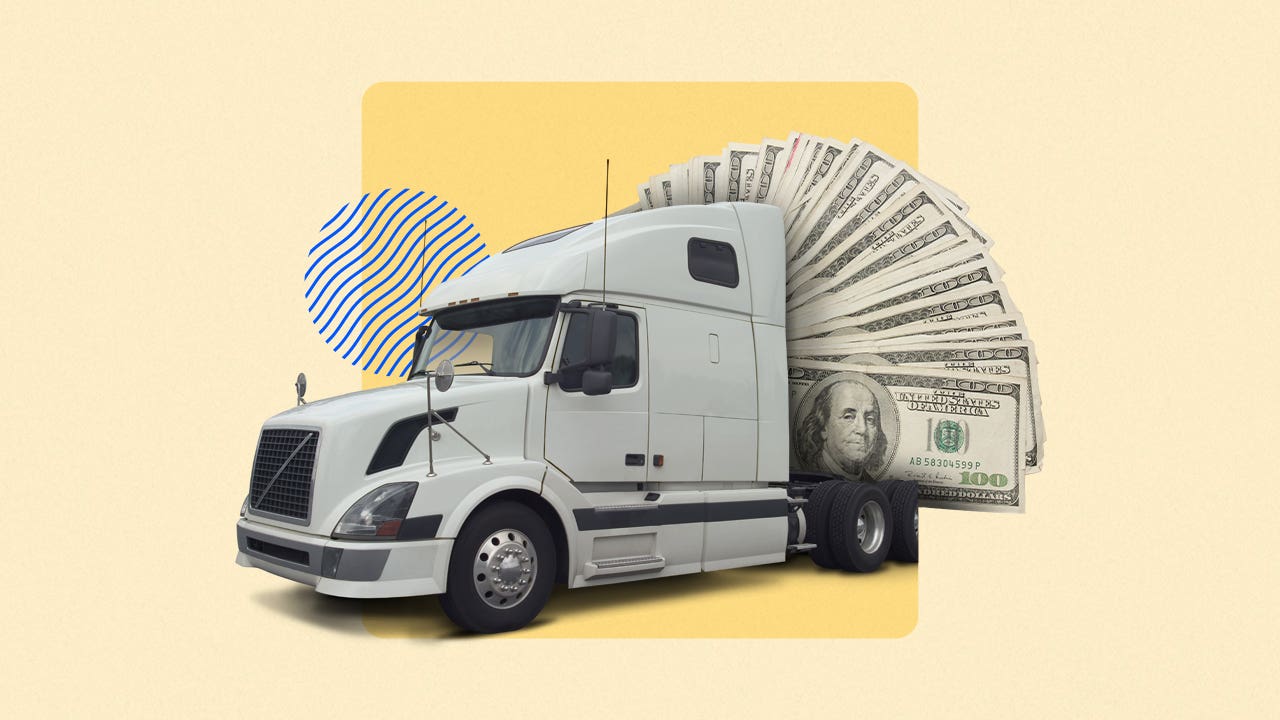How to get semi-truck financing

Key takeaways
- A semi-truck loan, lease or line of credit are all options for business owners who need financing to buy a semi truck.
- Your credit score will play a significant role in your ability to qualify for a loan, but you can find loans for bad credit from specific lenders.
- Compare loan offers from multiple lenders to find the lowest cost and loan terms available to your business.
A single new semi truck can cost up to $200,000 with insurance, registration and other fees on top of the cost of the truck itself, meaning that financing a semi-truck fleet can easily cost you millions. If you don’t have the cash on hand to buy the vehicles you need, semi-truck financing can get you off the ground. Here’s everything you need to know about applying for semi-truck financing.
1. Check your credit
Lenders reserve the best interest rates and terms for borrowers with high business and personal credit scores, making them a crucial part of keeping your loan costs manageable. Many lenders will also require a minimum credit score to even qualify for a loan.
Factors that impact a credit score include:
- Current outstanding debt
- Bill payment history
- Number of credit accounts open
- Types of credit you use
- How long your accounts have been open
- Percentage of available credit being used
- Past bankruptcies, foreclosures or collections attempts
While you can get a business loan with bad credit, it’s easier to get approved if you have a credit score in the good or excellent range. As a general rule, a person FICO credit score of at least 670 is considered good.
Business credit score models vary, but some, like your Paydex score, have a range from 1 to 100. A Paydex score of 80 to 100 suggests that you’re a strong candidate for a business loan. If you’re not sure what your current credit rating looks like, look at your business credit reports.
2. Determine what type of loan you want
There are a few different types of business loans that you can use to finance a semi truck. The most common options include:
| Loan type | Overview | Pros | Cons |
| Business loans |
|
|
|
| Equipment loans |
|
|
|
| Business line of credit |
|
|
|
| SBA 7(a) |
|
|
|
| SBA 504 |
|
|
|
How loan is right for you will depend on your credit score, how much interest and fees you can afford and which lender you decide to work with.
3. Determine how much loan you can afford
Your financing amount will depend on two factors, which are somewhat tied together: How much you’re approved for, and how much payment you can afford. Lenders will used your monthly revenue (or projected revenue), your credit history and the value of the equipment you plan to purchase to determine how much they’ll lend you.
Another factor to consider is how much payment you can handle. Even if your lender approves you for a higher amount, taking on too high of a payment can quickly overwhelm your budget. Working backward from your desired payment using a loan calculator can help you determine how much you can afford to borrow.
Using a business loan calculator can help you determine how much loan you can handle, which will aid in comparing business loans.
For example, if you determine that you can afford a $5,250 monthly payment, with an 11.5 percent APR and a six-year repayment period, you’ll be able to afford a loan of $285,104.
4. Find a semi-truck lender
When choosing your lender, think about your priorities. Do you want the cheapest loan or the fastest funding? Determine what features are most important to you and then research these types of lenders:
| Lender | Best for | Pros | Cons |
| Banks and credit unions |
|
|
|
| Direct lenders |
|
|
|
| Online lenders |
|
|
|
| Alternative lenders |
|
|
|
In 2024, the average SBA 504 loan amount was $1,112,115. A total of $6,664,906,000 in 504 loans were approved in that same year, with nearly 6,000 loans distributed.
5. Get prequalified
Getting prequalified for commercial truck financing means a lender has assessed your business history and credit score and determined that you’re likely to qualify. They may run a soft credit check to gauge your creditworthiness, but it doesn’t affect your credit score.
While getting prequalified doesn’t mean you’re officially approved, it means you’ve met a lender’s initial criteria and understand how much you might qualify for.
6. Find the type of semi truck you want to finance
You may be able to expedite your loan if you can tell the lender which vehicle you want to purchase and the price. Similar to buying a car, having more information about the vehicle rounds out your loan application. Some lenders may require detailed information about the semi truck, including the make, model, year, condition report and past repairs. It also helps to have photos.
Narrow down the type of truck for you by looking at several factors:
1. Compare new and used. New semi trucks are more expensive but may have a longer warranty and require fewer repairs. Used trucks can have lower monthly payments but may come with a shorter warranty window.
2. Narrow down specifications . Long-haul drivers will need a sleeper cab, while short-distance drivers can get by with a day cab. Consider your preferred fuel economy, type of truck, automatic or manual transmission and other features that make your job easier.
3. Always run a history check. For used trucks, check out the vehicle’s history report for details such as the title, accident and maintenance records. You might want to opt for a truck with low mileage and a detailed maintenance history that has included few major repairs, as this will be more likely to be approved by banks.
4. Be realistic with your budget. Leave room in your business budget for future semi-truck repairs and upgrades by not financing more than you can afford upfront. You also don’t want to drain your business emergency fund just to finance a semi truck.
7. Get the right insurance
Your lender may not release funding for your loan until they know you have the right insurance for your truck. Truck owners will need to meet their state’s minimum insurance coverage, as well as additional coverage for the truck, trailer and cargo. You may also want worker’s compensation insurance if you have employees. Here’s a look at the common types of semi-truck insurance you’ll come across:
- Primary liability coverage. This covers damage to property or people caused by your truck while it is on the road.
- Physical damage insurance. This insurance can cover some physical damage to your truck in the event of an accident, theft or natural disasters.
- Uninsured/underinsured motorists. This insurance kicks in to cover damage to your truck or injuries to you if you get hit by an uninsured or underinsured driver.
- Bobtail insurance. This liability coverage covers damages to other vehicles and injuries to other people that occur when you drive your semi truck without a trailer.
- Non-trucking liability coverage. This protects you from liability claims that could occur when you use your semi truck for personal travel, such as when you’re driving your truck home for the day.
- Cargo liability insurance. This insurance coverage helps you replace cargo that is damaged or lost during an incident such as an accident, storm or theft.
- Reefer breakdown insurance. This insurance covers refrigerated semi trucks, helping to fund refrigeration breakdowns or lost cargo due to a breakdown or collision.
8. Apply for semi-truck financing
When you’re ready to apply for a semi-truck loan, you’ll need to verify that you meet the lender’s requirements. Then, gather the documents the lender requires to complete the application. Prepare to be asked questions about you, your business and the semi truck you’re financing.
Documents to have on hand when you apply for financing include:
- Business registration
- Employer Identification Number (EIN)
- Current business balance sheets
- Current business income statements
- Up to three years of personal and business tax returns
- Up to one year of bank statements
- Commercial driver’s license (CDL)
- Proof of truck insurance
Once you apply, the lender will reach out to you to finalize the loan. You will want to thoroughly review the loan agreement. Take this time to ask the lender questions and negotiate the loan terms if you want different terms. Once you understand all the details, sign the loan agreement and wait to receive the funding. Funding can take a few days to be cleared by your bank before you can use it.
Bottom line
Semi-truck financing grants access to funds that you can use to start or grow a trucking business. But before you apply for a business loan, you can do your research on truck costs, the type of truck and truck loan you need and the right lender that will approve your business. That way, you can come to the lender armed with information to expedite the approval process.
Frequently asked questions
Why we ask for feedback Your feedback helps us improve our content and services. It takes less than a minute to complete.
Your responses are anonymous and will only be used for improving our website.
You may also like

How to build credit to buy a car: 4 tips

6 steps to get the best auto loan rates

Where can I get semi-truck financing?




